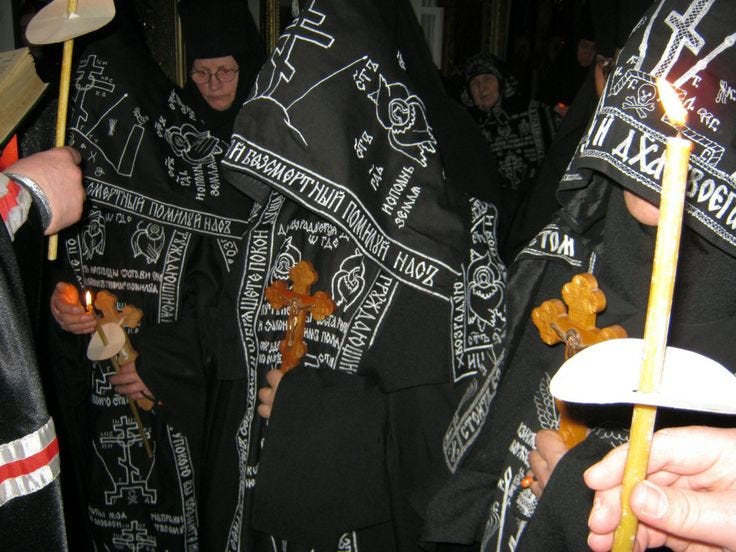In my recent research on Eastern Orthodox Christianity, I am discovering an incredibly rich, deeply mystical, and beautiful tradition that does not cater to modern preferences. One aspect of the religion that presently amazes me is the schemamonks…
Schemamonks are Olympian spiritual athletes, the Navy SEALs of prayer, who are not only praying for the salvation of their own souls but for all of ours. There are levels to this, and just knowing they exist fills me with joy. They are seldom seen, as the Great Schema is rarely granted. Here is rare footage of one:
What I learned from researching them is:
The Great Schema is the final stage of monasticism in Eastern Orthodoxy.
Those who receive it are given a new name, indicating their spiritual rebirth.
They wear the “Analavos of the Great Schema,” embroidered with the Instruments of the Passion, symbolizing their absolute devotion to being "nailed to the cross" alongside the God-man.
Few in the world today are of the Great Schema, rarely seen, often tucked away on Mount Athos, praying without ceasing.
Many seek out their counsel, for the depth of spiritual wisdom they offer is profound.
I’d like to meet one. One place you won’t meet one is on social media. Schemamonks don’t do social media. Being active online is a Faustian bargain. I do not think it’s wise for spiritual leaders to be overly active online, as they risk becoming servants of the spectacle, seeking attention more than seeking God.
The spectacle is French philosopher Guy Debord’s term for what can now be seen as the internet. He defined it as "a social relationship between people that is mediated by images." The spectacle hides reality, commodifies relationships, and offers countless distractions through representations of the real, resulting in “the decline of being into having, and having into merely appearing.”
Yes, the spectacle will attempt to recuperate images of schemamonks, catching glimpses of them being in the world and attempting to die to it, but you will not find them personally feeding the spectacle. The reason I feel joy upon reflecting on them is that they care about being, not merely appearing. They venerate icons, but they do not turn their image into icons to be venerated, as influencers attempt to do today.
Now, despite my bouts of pessimism, I am trying to be an internet-realist these days: someone who sees the individual dangers of the internet, as well as the collective risks, but does not argue that we should do away with it completely. Rather, I wonder what being in right relationship with the internet looks like, or what a “wise internet” could be like. With these considerations in mind, what can we learn from the schemamonks?
Firstly, the discipline of being is important. Without it, the trend from being to having to appearing becomes inevitable with today’s technology. With such discipline, perhaps an inverse trend—from appearing to having to being—can occur. Perhaps the internet can become a place that inspires us to be more fully present in the world. I remain optimistic that the spectacle could be transformed into something else—a spiritual opportunity.
Most are not called to the monastic life, especially to the intensity of the Great Schema. They are meant to be in the world, which is challenging because their discipline cannot be forged in the “total institution”1 of a monastery. However, by reframing the spectacle, it can be seen as an opportunity for temperance training—a way to exercise one’s resolve when faced with the pull of the screens.
If schemamonks can resist the pull of the world, we can resist the pull of the screens, say no to the spectacle, and begin to negotiate what the internet can become. I do not believe a true internet-realist perspective can emerge if we continue to serve the spectacle as we have. We can reinvent the internet, but first, we must begin serving something else.
If you have any questions, insights, feedback, or criticism on this entry or more generally, message me below (I read and respond on Saturdays) …
“A total institution may be defined as a place of residence and work where a large number of like-situated individuals, cut off from the wider society for an appreciable period of time, together lead an enclosed, formally administered round of life.” - Erving Goffman


